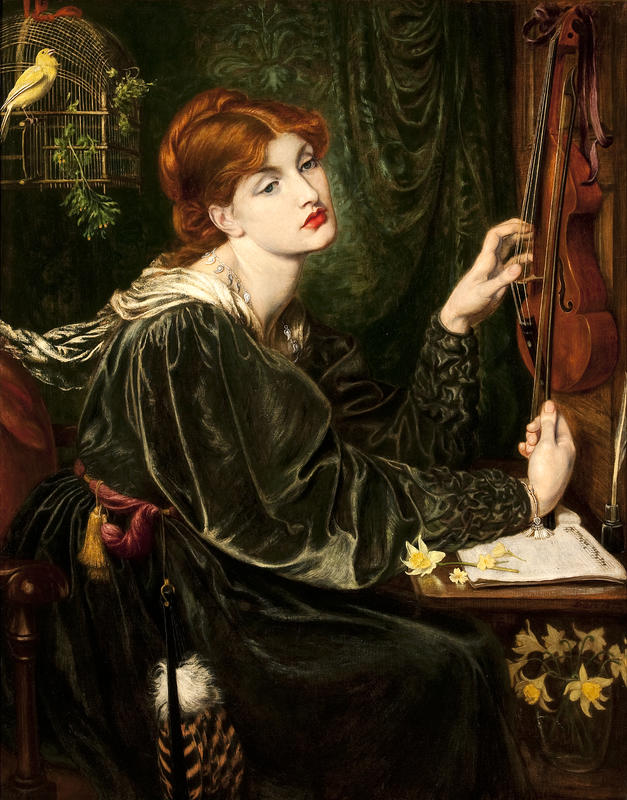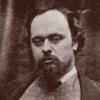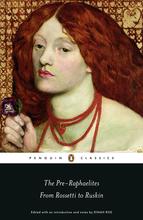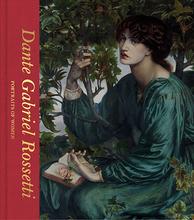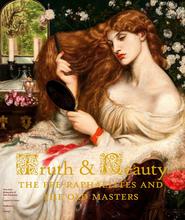More about Veronica Veronese
- All
- Info
- Shop
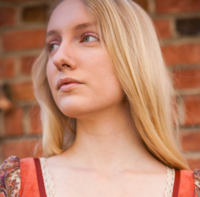
Editor
Languid, Luxurious, and long of neck, Veronica Veronese is an example of one of Dante Gabriel Rossetti’s “stunners”--paintings that strayed from the tenets of Pre-Raphaelitism, the very art movement he founded.
As a young artist working alongside fellow Pre-Raphaelites Millais and Hunt, Rossetti had focused on narrative paintings and illustrations typically of biblical and medieval stories. But starting around the 1860s, he deviated from his Pre-Raphaelite principles and began to paint dreamy, bust- and ¾-length images of beautiful women with no obvious stories or morals attached. Sumptuously painted, these works are not portraits. They are ruminations. They evoke themes and revel in beauty, but are more in line with the budding Aestheticism movement’s idea of “Art for Art’s Sake” than the quest for moral purity that had characterized his work before.
Painted in 1872, Veronica Veronese is one such example of this new, more secular style. The painting is thought to represent the artistic soul suspended in the act of creation. Sometimes art historians have to theorize long and hard about what a painting means, but in this case, Rossetti provided us with a rather lengthy inscription purported to be by one Girolamo Ridolfi (who was probably Rossetti himself, or possibly his friend Swinburne) that explains the entire picture. Written in French around the frame, it describes the “Lady Veronica” pausing while writing music, listening to the bird’s inspiring song and searching for the elusive melody. It ends with saying, “It was the marriage of the voices of nature and of the soul--the dawn of a mystic creation.”
Heavy-handed much? Perhaps. The various objects in the painting may have symbolic meaning, drawn from Cesare Ripa’s “Iconologia,” that enhance the theme of musical creation–the daffodils perhaps indicating reflection, the canary representing the unbridled human soul. But just as important as the theme to Rossetti was the overall aesthetic experience of the painting, and he himself described the work as a “study of varide [sic] greens.”
And indeed, in turning away from the medieval subject matter of his past, Rossetti also turned away from his former linear style, and began finding inspiration in the work of the High Renaissance, prioritizing volume and color. He drew from the late Mannerism of Michelangelo as well as the work of Venetians like Titian and especially Veronese. On his honeymoon in 1860, he saw Veronese’s Wedding at Cana and he proclaimed it to be “the greatest picture in the world beyond a doubt.” It’s no wonder he titled this painting “Veronica Veronese.” The luscious female figure and sumptuously rendered green tones and fabrics distinctly hearken back to works like Veronese’s Lucretia.
Through this stylistic pivot, Rossetti was not without an audience for these opulent images. This work was commissioned by the wealthy shipping magnate F. R. Leyland. Leyland owned several other “stunners”, as he called them, and this painting may have particularly resonated with him as he was an amateur violinist. (Leyland is also the guy who commissioned Harmony in Blue and Gold: The Peacock Room from Whistler, but that didn’t go over as well.)
One person who did not appreciate these later works, however, was his old Pre-Raphaelite buddy William Holman Hunt. The serious-minded Hunt felt that Rossetti was casting aside stoicism in favor of epicureanism, thereby abandoning the principles of the movement (to which Hunt alone was still adhering) for the merely decorative. In response to Rossetti’s first painting of a woman in his new style, Bocca Baciata, Hunt said that it was “marked by a gross sensuality of a revolting kind, peculiar to foreign prints, that would scarcely pass our English custom house from France…” No word on whether Rossetti cared what Hunt thought.
The model for this painting was Alexa Wilding, whose face appears in more of Rossetti’s completed paintings than that of any of his other models. Rossetti began working with Wilding when he started having a hard time selling paintings featuring his then-model and mistress, Fanny Cornforth, whose features were broad and wholesome. In comparison, Wilding’s beauty was more angular and created a compelling contrast with his voluptuous settings. She was quiet and sphinx-like, and Rossetti’s assistant described her as being “full of quiescent, soft, mystical repose,” though Rossetti thought she was neither “gifted nor amusing.” Despite his rudeness, however, Wilding still possessed some affection for the man, and when he died, was one of very few models who went to his funeral and made visits to his grave, even when her own health was poor.
Sources
- Buron, Melissa E., Susanna Avery-Quash and Fine Arts Museums of San Francisco. Truth & Beauty: The Pre-Raphaelites and the Old Masters. San Francisco: Fine Arts Museums of San Francisco/Legion of Honor; DelMonico Books/Prestel, 2018.
- Faxon, Alicia Craig. Dante Gabriel Rossetti. New York: Abbeville Publishers, 1989.
- Spencer-Longhurst, Paul. The Blue Bower: Rossetti in the 1860’s. London: Scala Publishers, 2000.
- Stonell Walker, Kirsty, and Kingsley Nebechi. Pre-Raphaelite Girl Gang: Fifty Makers, Shakers and Heartbreakers from the Victorian Era. London: Unicorn, 2018.
- “Veronica Veronese.” Delaware Art Museum. Accessed July 14, 2022. https://emuseum.delart.org/objects/321/veronica-veronese.
Featured Content
Here is what Wikipedia says about Veronica Veronese
Veronica Veronese is an oil painting by Dante Gabriel Rossetti painted in 1872 with Alexa Wilding as the model. The painting was conceived as a companion to Lady Lilith. Rossetti sold the painting to one of his best clients, shipping magnate Frederick Richards Leyland. In 1923 it was acquired by the estate of Samuel Bancroft which donated it in 1935 to the Delaware Art Museum.
Check out the full Wikipedia article about Veronica Veronese

